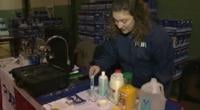LeeAnne Walters is continuing her fight for justice following the Flint Water Crisis 10 years later.
FLINT, Mich. (WJRT) - LeeAnne Walters still has a bottle of discolored water that came from the faucet in her Flint residence 10 years ago.
It's the same aged and dented bottle the mother held up to show something was wrong with the Flint water supply in 2015, nine months after the city began drawing from the Flint River.
Although most of the water evaporated, the bottle still holds the truth she fought to make everyone else see.
"It brings back some very bad memories -- infuriating memories -- being at a meeting holding this up and being called a liar," Walters said.
She first showed the bottle of brown water on Jan. 21, 2015, about nine months after the emergency manager who was in charge of Flint's government switched the city's water supply from Detroit's system to the river on April 25, 2014.
Flint residents erupted at a packed meeting in City Hall. They were breaking out with rashes and fearing what was in their drinking water. But "experts" from the city and state tried to convince those using Flint's water that it was safe.
Walters held up her bottle of brown water, but that wasn't enough to convince the city of Flint and Michigan Department of Environmental Quality that something was wrong. They didn't believe her.
"They were dismissive and didn't want to hear anything we were saying -- didn't want other people to hear what I was saying," Walters said.
The experts in that meeting claimed the contents of her bottle were not her tap water.
"You can see the sediment still there," Walters said. "Crazy, right? To think they said that it didn't come out of my tap."
She is not a scientist, doctor or water quality expert. But she was a mother and knew that whatever was coming out of her faucets was hurting her family.
Walters lost her eyelashes and a bunch of her hair after showering in the water. Her eyelashes still haven't grown back 10 years later.
Her 3-year-old twin boys started getting red bumps after baths in 2015 and her whole family was breaking out in rashes. The skin irritation lingers a decade after the water switch and they were first exposed.
"We still have rashes. (It) doesn't matter where shower, we still in same spots, we have rashes," Walters said.
The rashes affect her boys' ankles and between their toes while her daughter has rashes on her sides. Walters has rashes on her shins and her husband has them on his sides, as well.
"It started end of may 2014 and it doesn't go away," she said.
Walters began researching what could be causing the problems affecting her children and others across Flint.
"We realized we are not alone and how do we make them listen?" she said.
Walters urged the city to test her water. She got a chilling phone call from Flint Water Plant Supervisor Mike Glasgow warning her to keep her children away from the water.
While the city of Flint was telling residents their water was safe, Walters learned that hers had alarmingly high lead levels. She educated herself on the terrifying and heartbreaking effects lead exposure can have on young children.
Exposure to lead contamination can cause irreversible neurological damage to developing brains, including lower IQs, problems with attention span and behavior issues.
There is no safe level of lead, but the federal action level where corrective action must be taken was 15 parts per billion in 2015. The first test at Walters' house came back seven times that at 104 parts per billion.
Another test the next month was even more disturbing with a lead level of 397 parts per billion. Additional tests would average 2,500 parts per billion and the highest came back at a stunning 13,000 parts per billion, which is 2.5 times what would be considered hazardous waste.
Walters' family had been using bottled water for months, but it was too late. All of them were exposed and her twin son Gavin, who had a compromised immune system, suffered from lead poisoning.
Twins Gavin and Garrett were 2 years old when the water crisis started. They remember their mom warming bottled water on the stove for their baths and they don't remember a time in their life where they haven't used water out of a bottle.
Both boys struggled with hand-eye coordination, memory loss and signs of attention deficit hyperactivity disorder. Gavin faced serious developmental delays and there was a time where he was a foot shorter than his twin brother.
But during the past 10 years, Walters and her husband Dennis have done everything possible to get them the therapy and support they need to rise above the effects of lead exposure
"No kid should have to go through this," Dennis said. "Watching them be delayed because someone made a stupid decision sucks, but we aren't treating them as victims. We are survivors."
LeeAnne tried desperately to get her boys tested for lead during the water crisis, but she said her doctor refused. After years of investigation, she learned why.
"Finding out the emergency manager's assistant was my son's doctor's wife and that was reason my kids weren't treated properly, and they refused to test my kids," LeeAnne said.
One of the most hurtful moments of the crisis was reaching out to Flint Mayor Dayne Walling, who had told her to come see him if anything changed.
"So when Gavin's doctor called to tell us about the lead poisoning, I immediately went down to his office. And I was told he would call me Monday," she said. "Monday never came."
Instead of meeting with Walling, Walters said she was sent to the city's Legal Department and asked to fill out a damage claim form.
"They wanted me to put a number in. How do a put a number on my child's life," she said.
The city of Flint then hooked up garden hoses from Walters' house to her neighbor's house to provide water for Walters' family.
She said the city offered to replace her water service line and pay her water bills if she would sign an agreement to hold the city harmless for five generations of her family.
"I refused to sign it and still to this day wouldn't," Walters said.
She documented it all with a home video showing the hose stretched between their homes. It went on for five weeks. The family got a staph infection and she said the city even threatened to take away her children.
"When I refused to hold harmless the city, that was one of the threats they made: They could remove my children from my house," Walters said.
The city and state blamed her plumbing for the high lead levels and kept assuring the community that Flint's water was safe through it all.
"It got to the point at council meetings that I had to use a different name to speak," Walters said. "They weren't going to let me talk. They didn't like the questions I was asking. Boy did they not know what they were in for after that."
She refused to give up for her children and the city.
"We knew my kids were harmed. We knew my son was poisoned," Walters said. "Nobody has a right to hurt people -- children -- and people had a right to know. Trying to discredit everybody with all of us knowing there is something wrong and turning a blind eye, how do you sleep at night?"
She took her fight to the Environmental Protection Agency. Miguel del Toral came out to test her water and help her uncover a bombshell.
"I got all the reports from the Water Department. I was teaching myself about water, trying to figure out chemical makeup and how much has to go in there and I wasn't finding anything for corrosion," Walters said.
Del Toral tried to help her understand the chemical makeup in Flint's water system. She read him lists of everything listed in monthly reports covering a year and eventually sent them.
"I can't repeat what he said. He was like, Oh my God, they aren't using corrosion control,'" Walters said.
Without that federally mandated treatment, Flint's river water was so corrosive that aging pipes were leaching unsafe levels of lead into the water supply.
Emails show Del Toral raised his concerns with Michigan Department of Environmental Quality engineer Steve Bush, who assured the EPA that Flint was using proper corrosion control. However, they were not.
"They were in game mode to make sure they kept face, everything was fine. I was more crazy than ever," Walters said. "If you look at FOIAs, they are trying to figure out ways to come after me and my plumbing my house."
Del Toral visited Walters' house and determined that all of her interior plumbing was plastic and could not be the source of high lead levels.
He tested the water service line that the city removed and found that a portion was galvanized iron and a lead service line was linking her house to the water main at the street.
"That fateful day of just calling to ask a simple question turned into something none of us expected," Walters said. "Somebody who knew laws and regulations and how everything worked, who was being honest and not candy coating or lying and from that it lead figuring out what the problem was."
That determination came in April 2015, one year after the water switch. But state regulators still did nothing.
"They didn't bother to do anything to put in corrosion control until the end of November 2015. It went that much longer," Walters said. "For the cost of a $75,000 machine $100 a day, this all could have been avoided."
The city continued to maintain the water was safe, but Walters put her two boys in a wagon and began walking door to door warning people about lead poisoning.
A decade later, the twins remember riding in the wagon and now realize just how brave their mother was. Some of her neighbors tell her those warnings made a life-saving difference.
"I have neighbors that to this day will tell you their children -- they had miscarriages and stillbirths during that time and it was me going and talking to them -- and that they chose not to drink the water and they will tell you their children are here because they listened," Walters said.
Ten years later, she and her family are still working to protect others by sharing their story in classrooms. They are still fighting for justice in a civil lawsuit against those she believes are responsible for poisoning her children.
"People died because of this. My kids' lives are forever altered, but people lost their family members -- their loved ones," Walters said. "To me, that and miscarriages and stillbirths -- that is not OK and all those people get to walk away from it. Sorry, but that is a hard pill to swallow."
Like so many across the city of Flint, they are still waiting for someone to be held accountable
















